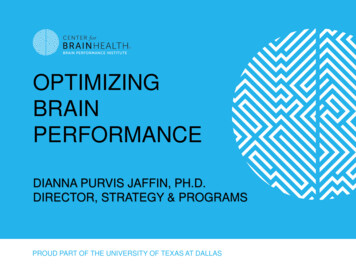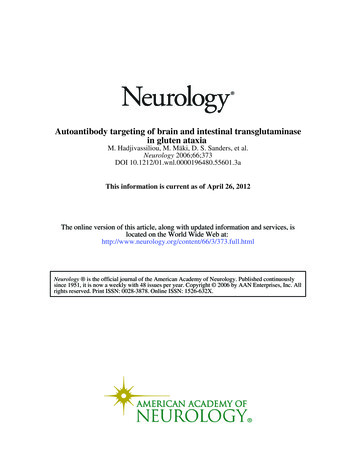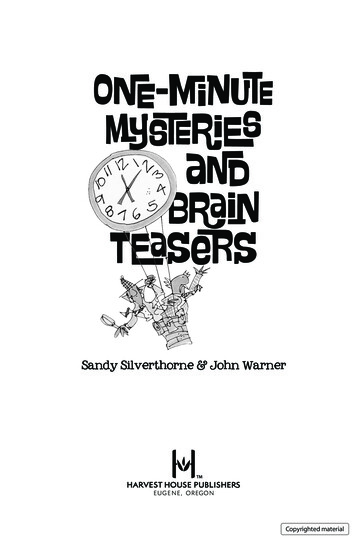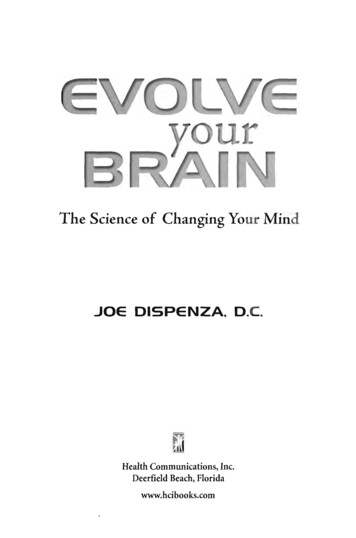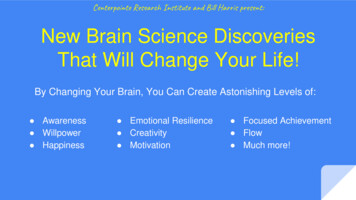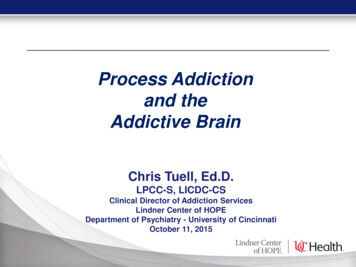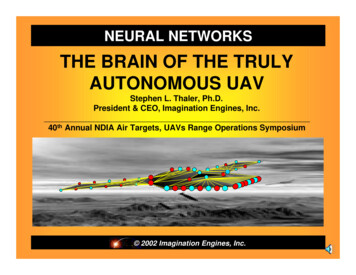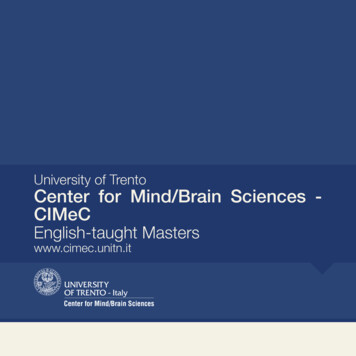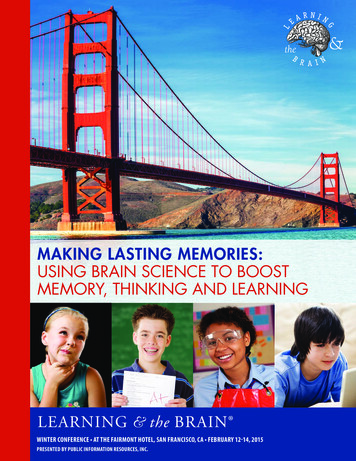
Transcription
MAKING LASTING MEMORIES:USING BRAIN SCIENCE TO BOOSTMEMORY, THINKING AND LEARNINGLEARNING & the BRAIN WINTER CONFERENCE AT THE FAIRMONT HOTEL, SAN FRANCISCO, CA FEBRUARY 12-14, 2015PRESENTED BY PUBLIC INFORMATION RESOURCES, INC.
Motor CortexSensory CortexThalamusCorpus CallosumFrontal CortexPituitary GlandPonsCerebellumMedullaMidbrainLEARNING & the BRAIN Conference is presented by Public Information Resources, Inc.Address: 35 Highland Circle, First Floor Needham, MA 02494-3099 Phone: (781) 449-4010 Fax: (781) 449-4024 Web: LearningAndTheBrain.com
LEARNING & the BRAIN 40TH CONFERENCE SAN FRANCISCO, CALIFORNIA WINTER 2015TABLE OF CONTENTS:23–5Fairmont Hotel and Sessions MapSchedule-at-a-Glance6Welcome from LEARNING & the BRAIN 7Welcome from the Laboratory of Educational NeuroScience, UCSF8Welcome from Kenneth S. Kosik, MD, UC Santa Barbara9Welcome from David B. Daniel, PhD, James Madison University10–11Thursday Pre-Conference Workshops (Feb. 12)12–23Detailed Conference Program (Feb. 12-14)12–13 THURSDAY14–18 FRIDAY19–23 SATURDAY24Hotel and Local Food Locations (Breakfast/Lunch/Dinner)25LEARNING & the BRAIN Conference May 7-9 – New York City26Poster Sessions, Book Signings and Reception27In-Depth LEARNING & the BRAIN 2015 Summer Institutes28–31Conference Faculty32Exhibitors33LEARNING & the BRAIN Theme CDs34Continuing Education (CE/CEU) Credit Information35–36Evaluation Form for Educators/Clinicians37–40Note PagesLinks to Speaker Handouts are located EARNING & the BRAIN is presented by Public Information Resources, Inc. (PIRI)35 Highland Circle, First Floor, Needham, MA 02494-3099President: Daniel LaGattutaVice President/Conference Director: Kelly WilliamsEvent Manager: Kristin DunayResearch/Conf. Assistant: Emily ForzanoRegistration: Adelaide Cusack and Tanya WilsonEmail: info@LearningAndTheBrain.comWeb: LearningAndTheBrain.comPhone: (781) 449-4010
FAIRMONT HOTEL AND SESSIONS MAPFAIRMONT HOTEL MAPLOBBY LEVELPre-Conference Workshops on the morning ofFeb. 12th will take place in the Fairmont Hotel in theFrench, Pavilion, Fountain, Garden and Crystal Rooms(which are all located on the Lobby Level) and in theTerrace Room (located on the Terrace Level, two floorsbelow the Lobby Level).All Keynote Presentations for Feb. 12-13 will takeplace at the Fairmont Hotel in the Grand Ballroom(for Group A attendees) located three floors belowthe lobby and in the Venetian Room (for Group Battendees) located on the Lobby Level.The Grand Ballroom is only accessible from the TerraceLevel. Take the elevator to T (Terrace Level) and makea right or take the Laurel Court stairs down until theyend at the Terrace Level and make a right and thena left. Follow the hallway and go down the escalators(near the Tonga Room Bar) to the Grand Ballroom Level.TERRACE LEVELFriday and Saturday Concurrent Sessions will takeplace at the Fairmont in the Grand Ballroom (locatedon the Grand Ballroom Level), the Terrace Room(located on the Terrace Level), the Gold, Venetian,Pavilion and French Rooms (located on the LobbyLevel) and the Crown Room (for Friday session only). Fairmont Hotel and Sessions MapGRAND BALLROOM2Crown Room: Take Tower Suite elevators (locatedbetween the Gold and Crystal Rooms on the LobbyLevel) to the 24th Floor.Coffee will be served Thursday afternoon and Fridayand Saturday mornings in the Grand Ballroom Lobby andthe Cirque Room (near the Venetian Room on the LobbyLevel). Poster Sessions, Exhibits, Book Signings andHelp/Information Desk will all be located in the GrandBallroom Lobby/Lounge area during the conference.CONCURRENT SESSIONS GUIDE:(RP) Brain Research & Practical Strategies/Interventions(P) Mostly Brain-Based Practical Strategies and Interventions(R) Mostly Brain/Child Development Research(K-College, K-12th Grade) Applicable Grade Levels
LEARNING & the BRAIN CONFERENCE SCHEDULE-AT-A-GLANCEThursday, February 12, 2015 Pre-Conference Workshops8:30 am – 12:35 pm Located on the Lobby Level and Terrace Level (Below Lobby) of the Fairmont San Francisco Hotel1) WorkingMemory2) Test Taking& Study Skills3) CommonCore Standards4) ReadingDifficulties5) The Powerof Technology6) Teen Brains,Memory & MovesRoom: TerraceRoom: FrenchRoom: GardenRoom: FountainRoom: CrystalRoom: Pavilion8:30 am – 12:35 pm8:30 – 10:30 am8:30 am – 12:35 pm8:30 am – 12:35 pm8:30 am – 12:35 pm8:30 – 10:30 amUnderstanding,Assessing andStrengtheningWorking MemoryMilton J. Dehn, EdD, NCSPPart I: WinningStrategies forImprovingTest TakingKathleen M. Kryza, MAManaging andEngaging Studentsin the CommonCore ClassroomBryan K. Harris, EdDThe Role of ExecutiveFunctions in Readingand ReadingDifficultiesGeorge M. McCloskey, PhDTeach the CommonCore Literacy StandardsCreatively with thePower of TechnologyPart I: Teachingand Moving theTeen Brain ThroughMovementJean Blaydes Moize, MEd(P, K-College)(P, K-College)(Below Lobby)12:35 – 1:45 pm(Lobby Level)(P, K-12th Grade)(Lobby Level)(P, PreK-12th Grade)(Lobby Level)(P, K-12th Grade)(Lobby Level)Catlin R. Tucker, MA(P, 6-12th Grade)(Lobby Level)10:35 am – 12:35 pm10:35 am – 12:35 pmPart II: EmpoweringPart II: Creatingthe DisorganizedStudent: Tips,Strategies andSolutions to HelpStudents Studyand Become MoreSuccessful in SchoolAna R. Homayoun, MA, PPSRobust Memoryin Teens ThroughExperiential PracticesJeb Schenck, PhD andJessica Cruickshank, EdMLunch Break (On your own)Thursday, February 12, 2015 Conference Day 1 (Group A)1:45 – 5:30 pmOpening Keynote Addresses (located in the Grand Ballroom): The Science of Learning1:45 pmWelcome: Daniel A. LaGattuta, PhD, President, Public Information Resources, Inc.Opening Remarks: David B. Daniel, PhD, Department of Psychology, James Madison University1:45 –2:45 pmKeynote Address I: Making It Stick: The Science of Successful Learning and MemoryHenry L. Roediger, III, PhD2:45 – 3:15 pmNetworking Coffee Break and Dr. Roediger Book Signing (Grand Ballroom Lounge – See page 26)3:15 –4:15 pmKeynote Address II: How the Body Knows Its Mind: The Surprising Power of the Physical Environment4:15 –4:30 pmSpecial Keynote Activity: Putting Learning into Action4:30 –5:30 pmKeynote Address III: How We Learnto Influence How You Think and FeelSian L. Beilock, PhD (Book signing from 5:30-5:45 PM in the Grand Ballroom Lounge)Benedict J. Carey, MA (Book signing from 5:30-5:45 PM in the Grand Ballroom Lounge)5:30 – 6:30 pmDana Alliance Meeting of the Minds Reception (Gold Room - Lobby Level)CONCURRENT SESSIONS GUIDE:(RP) Brain Research & Practical Strategies/Interventions(P) Mostly Brain-Based Practical Strategies and Interventions(R) Mostly Brain/Child Development Research(K-College, K-12th Grade) Applicable Grade Levels Schedule-at-a-GlanceJean Blaydes Moize, MEd3
Friday, February 13, 2015 Conference Day 2 (Group A)8:30 am – 12:30 pm Keynote Addresses (located in the Grand Ballroom): The Science of MemoryWelcome Remarks: Kenneth S. Kosik, MD, UC Santa Barbara; Co-Founder, LEARNING & the BRAIN 8:30 amKeynote Address I – How the Brain Learns and Remembers8:30 –Sandra B. Chapman, PhD9:45 am9:45 – 10:10 am10:10 –11:10 amCoffee Break, Poster Sessions & Dr. Chapman Book Signing (Grand Ballroom Lounge – See page 26)Keynote Address II – The Structure and Organization of MemoryLarry R. Squire, PhD11:15 am – Keynote Address III – Memory in the Age of GoogleWilliam R. Klemm, DVM, PhD12:30 pm12:30 – 1:45 pmLunch Break (On your own) and Keynote Book Signings (Grand Ballroom Lounge – See page 26)1:45 – 5:35 pmAfternoon Concurrent Sessions ‘A’ (Groups A & B) (Breaks, Various times, 3:00-3:10 pm; 4:10-4:20 pm)1) Scienceof Learning(RP, K-College)2) MakingLasting Memory(RP, K-College)3) Embodied MindsLanguage/Thinking4) Motion, the Arts& Learning5) Active Learning &STEM Education6) Memory& Encoding(RP, PreK-College)(RP, PreK-College)(RP, 4th Grade-College)(RP, K-College)Room: GrandRoom: GoldRoom: VenetianRoom: PavilionRoom: Crown (24Room: Terrace1:45 – 3:00 pm1:45 – 3:00 pm1:45 – 3:00 pm1:45 – 3:00 pm1:45 – 3:00 pm1:45 – 3:00 pmPart I: The IncreasingImportanceof LearningHow to LearnRobert A. Bjork, PhDPart I: Sleep,Learning andLasting MemoryMatthew P. Walker, PhDPart I: How BrainsThink: EmbodiedCognition, Languageand MetaphorsGeorge P. Lakoff, PhDPart I: A Bodyof Knowledge:GroundingMathematicalConcepts inEmbodiedInteractionDor Abrahamson, PhDPart I: How Memoryis Encoded and ItsRole in ImaginationKenneth S. Kosik, MD(Book signing from3:00–3:10 PM in theGrand Ballroom Lounge)Part I: EmbodiedExperiences: UsingNeuroscience andPhysical Movementto Enhance Memoryand EngagementAnne Bishop, EdM3:10 – 4:10 pm3:10 – 4:10 pm3:10 – 4:10 pm3:10 – 5:35 pmPart II: Walk forPart II: Body BasedPart II: The Neuro-Resources WhenReading-to-Learn inScience: Gestures andModel Enactment forSTEM LiteracyMitchell J. Nathan, PhDpsychology ofMemory andClassroom LearningGeorge M. McCloskey, PhD(Includes 10-minute break)Ballroom (GB Level)3:10 – 4:10 pm(Lobby Level)3:10 – 5:35 pm(Lobby Level)Part II: MemoryPart II: How OurPower:AGuidetoHands Help UsStudents Learn:Better Learning forThink and LearnActive Learning,TeachersandStudentsTesting and LongSusan Goldin-Meadow, PhDLasting MemoriesWilliam R. Klemm,Arthur P. Shimamura, PhD DVM, PhD(Includes 10-minute break) Schedule-at-a-GlancePart II: How4(Lobby Level)Thought: The LinkBetween PhysicalMovement andCreative ThinkingMarily A. Oppezzo, PhD, RDthFloor, Tower Elevator)4:20 – 5:35 pm4:20 – 5:35 pm4:20 – 5:35 pm4:20 – 5:35 pmPart III: Born toPart III: EmbodiedPart III: Memory andPart III: Mind forLearn: Motivatingand EngagingLearners from aDevelopmentalScience PerspectiveWendy L. Ostroff, PhDBrains and SocialMinds: ConnectingEmotional Minds andBodies to Learning,Thinking andMeaningful MemoryMary HelenImmordino-Yang, EdDthe Muse: How ArtsIntegrated InstructionCan ImproveStudent Engagement,Creativity andContent RetentionIvonne Chand O’Neal, PhDNumbers: Howto Excel in Mathand Science – andAnything Else YouStudyBarbara A. Oakley, PhD(Below Lobby Level)CONCURRENT SESSIONS GUIDE:(RP) Brain Research & Practical Strategies/Interventions(P) Mostly Brain-Based Practical Strategies and Interventions(R) Mostly Brain/Child Development Research(K-College, K-12th Grade) Applicable Grade Levels
Saturday, February 14, 2015 Conference Day 38:30 am – 12:30 pm1) Scienceof Learning(RP, K-College)Morning Concurrent Sessions ‘B’ (Groups A & B) (Coffee Break: 9:45-10:10 am, see page 19)2) MakingLasting Memory(RP, K-College)3) Embodied MindsLanguage/Thinking4) Motion, CCSS& Learning5) Active Learning& STEM Education6) Memory &Cognitive Control(RP, PreK-12th Grade)(RP, PreK-12th Grade)(RP, K-College)(RP, K-College)Room: GoldRoom: GrandRoom: FrenchRoom: PavilionRoom: TerraceRoom: Venetian8:30 am – 12:30 pm8:30 – 9:45 am8:30 – 9:45 am8:30 am – 12:30 pm8:30 – 9:45 am8:30 – 9:45 amThink Smart – forSchool and for LifeKathleen M. Kryza, MAand Jack A. Naglieri, PhD(Coffee Break: 9:45-10:10 AM)Part I: SurprisinglySimple Ways toBoost Memory andRecall: Strategies forEvery TeacherBryan K. Harris, EdDPart I: The Role ofGestures and theBody in Learningand TeachingMathematicsLaurie D. Edwards, PhDMovement, ActionBased Learning andCommon CoreState StandardsJean Blaydes Moize, MEd(Coffee Break: 9:45-10:10 AM)Part I: How to Makeand Use a “Sticky”Online Course toEnhance LearningBarbara A. Oakley, PhDPart I: School-BasedCognitive Training:Working Memory,Transfer and ADHDSusanne M. Jaeggi, PhD(Lobby Level)Ballroom (GB Level)(Lobby Level)(Lobby Level)(Below Lobby Level)(Lobby Level)(Book signing from 9:45–10:10 AM)(Book signing from 9:45–10:10 AM)10:10 am – 12:30 pm10:10 – 11:25 am10:10 – 11:25 am10:10 – 11:25 amPart II: Evidence-Part II: EmbodiedPart II: Flipping thePart II: Role of VideoBased Strategies ThatEnhance Long-TermMemory Encoding,Consolidation andRetrievalMilton J. Dehn, EdD, NCSPMeaning, Thinkingand CommunicationRaymond W. Gibbs,Jr., PhDFlipped Classroom:Reinventing Handson Learning in K-12STEM ClassroomsPaulo Blikstein, PhDGames in EnhancingCognitive Controland Motor SkillsJoaquin A. Anguera, PhD11:30 am – 12:30 pm11:30 am – 12:30 pm11:30 am – 12:30 pmPart III: Children’sPart III: ActivePart III: DevelopingEmbodied Learning:Exercise, Gestures,Executive Functionsand AchievementPatricia H. Miller, PhDLearning andAssessment in theSTEM ClassroomMary P. Wenderoth, PhDBrains and Memory:How MemoryImproves DuringChildhoodSimona Ghetti, PhD12:30 – 1:30 pmLunch Break (On your own) and Book Signing (See page 26)1:30 – 3:45 pmAfternoon Concurrent Sessions ‘C’ (Groups A & B)1) Scienceof Learning(RP, K-College)2) MakingLasting Memory(RP, 6th Grade-College)3) Embodied MindsLanguage/Thinking(RP, K-College)4) Motion, Teaching& Learning5) Active Learning& STEM Education6) Memory &Math Learning(RP, K-College)(RP, K-8th Grade)(RP, K-College)Room: VenetianRoom: TerraceRoom: FrenchRoom: GoldRoom: PavilionRoom: Grand1:30 – 3:45 pm1:30 – 2:45 pm1:30 – 3:45 pm1:30 – 3:45 pm1:30 – 3:45 pm1:30 – 2:30 pmMaking it Work:Translating LearningSciences to theClassroomDavid B. Daniel, PhDPart I: Using Personal Meeting NewThe Brain Scienceof Teaching:Using Mind-BodyConnections toOptimize LearningKathy Perez, EdDCreative Thinking,the Arts andSTEM EducationErica Fortescue, MAand Sara Norris, MAPart I: Math and(Lobby Level)(Below Lobby Level)Experiences to BuildStronger MemoryJeb Schenck, PhD2:45 – 3:45 pm(Lobby Level)Standards with OralLanguage Activitiesto Build AcademicThinking and ItsLanguageJeff A. Zwiers, EdD(Lobby Level)(Lobby Level)Ballroom (GB Level)Memory Training:Understandingthe Brain Basis ofProblem SolvingMiriam Rosenberg-Lee, PhD2:30 – 3:45 pmPart II: DevelopingMinds for Numbers:Networking SessionCONCURRENT SESSIONSGUIDE:Integrating BrainFacilitator:(R) Research onJebtheSchenck,Brain or PhDTechnology(RP) Research & Practical Classroom Strategies Systems for Number(P) Practical Classroom Strategies(K-COLLEGE) Appropriate Grade LevelSense and SymbolsBruce D. McCandliss, PhDPart II: Memory Schedule-at-a-Glance(Book signing: 12:30–12:45 PM)5
WELCOME TO THE WINTER 2015LEAR NING & the BR AIN CONFERENCEFortieth in a series of conferences exploring the potential for applying brain research to the improvement of memory and learning.Neuroscientists are discovering strategies that make content easier to learn, knowledgeeasier to remember and studying easier to accomplish through the “science of learning.”This conference will provide you with strategies for using mnemonics, meta-memory,metacognition, movement, active learning, gestures and retrieval practices to improve memory,thinking and learning.The LEARNING & the BRAIN Conference creates an interdisciplinary forum — a meetingplace for researchers, clinicians and educators — to examine this new research for the classroomand clinical practice.We hope you will walk away with new and useful information.LEARNING & the BRAIN CO-SPONSORS WELCOME YOUGraduate School of Education, Stanford UniversityDana Alliance for Brain Initiatives, The Dana FoundationLab. of Educational NeuroScience, University of California, San FranciscoBuilding Blocks of Cognition Laboratory, University of California, Berkeley Welcome from LEARNING & the BRAIN Gazzaley Cognitive Neuroscience Lab, University of California, San Francisco6The Neuroscience Research Institute, University of California, Santa BarbaraMind, Brain & Education Program, Harvard Graduate School of EducationComer School Development Program, Yale University School of MedicineNational Association of Elementary School Principals (NAESP)National Association of Secondary School Principals (NASSP)Edutopia, The George Lucas Educational FoundationThe John F. Kennedy Center for the Performing ArtsThe LEARNING & the BRAIN Foundation
Welcome letter from the Laboratoryof Educational NeuroScience, UCSFThe University of California, San Francisco’s Laboratory for Educational Neuroscience(UCSF brainLENS) is pleased to welcome you to the LEARNING & the BRAIN Conference, Making Lasting Memories. We are delighted, once again, to co-sponsorsuch a dynamic gathering of the field’s top thinkers.The 21st Century has brought with it nearly boundless opportunities, particularly in technology, but with theworld at our children’s fingertips, comes countless choices, distractions and noise. The topic Making LastingMemories could come at no better time. The conference promises to equip top educators with the tools necessaryto make lasting impressions in our noisy world.At brainLENS, too, we aim to foster innovation in research and training by inculcating an integration of differentdisciplines that will provide us with theoretical frameworks and research methodologies, which we can apply toeducation. We are committed to cutting-edge research to maximize all children’s potential, and in particular thosewith special needs. For example, we are currently investigating the impact that negative social cues may have onindividuals with learning disabilities. For those who struggle to learn, it is imperative that we understand attentionand memory in order to develop strategies to stave off distracters, sustain interest in academic tasks and createpositive emotional academic environments.This conference, Making Lasting Memories, aspires to stimulate us to integrate research findings and motivatenew collaborations and ideas for future research on how to improve learning and make it stick!Welcome and enjoy!Sincerely,Fumiko Hoeft, MD, PhDAssociate Professor and Director, UCSF brainLENS Welcome from the Laboratory of Educational NeuroScience, UCSFEducational neuroscience is a burgeoning field at the crossroads of biology, cognitive and developmental scienceand education that investigates the neuroscientific bases of learning and related processes. The Mind, Brainand Education field provides tremendous opportunities to illuminate processes of curiosity, emotional memory,metacognition, problem solving and so much more to better understand strategies to making lasting impressions.Innovative research is being conducted world-wide to harness technology, traditionally thought as distracting,such as video games, to potentially ‘train the brain’ and enhance cognitive abilities. There is a push to integratemovement and gestures to boost recall and creativity. Transforming the traditional connection of emotion andmemory combined with the initiative to foster healthy social and emotional learning pushes for education of thewhole child. With the combination of cognitive science and neuroscience practices and educational theories, wepush further into the blossoming intersection of neuroeducation. We hope you are as excited about this as we are!7
UNIVERSITY OF CALIFORNIA Santa BarbaraBERKELEY DAVIS IRVINE LOS ANGELES MERCED RIVERSIDE SAN DIEGO SAN FRANCISCOKENNETH S. KOSIK, M.D.Kenneth S. Kosik, MDHARRIMAN CHAIR IN N EUROSCIENCE RESEARCHWelcome letter fromCO-DIRECTOR: N EUROSCIENCE RESEARCH I NSTITUTEPROFESSOR, DEPT. OF MOLECULAR, CELLULAR & DEVELOPMENTAL BIOLOGYLSANTA BARBARA SANTA CRUZNEUROSCIENCE RESEARCH INSTITUTESanta Barbara, CA 93106-5060Phone: (805) 893-5222Fax:(805) 893-2005http://www.nri.ucsb.eduEARNING & the BRAIN in its February 2015 San Francisco conference will tackleprecisely what many of us now seek and what educators have sought for millennia:a way to boost human memory. And not just memory; we would like to boost manybrain functions. Increasingly it seems that brain science will deliver on this potential.But like any gift that seems too good, we have to look carefully at what lies inside the Trojan horse; what is writtenin the fine print of a Faustian agreement. From a medical perspective, boosting any facet of our biology is calledenhancement. This term is used to distinguish the concept of improving normal abilities from treating a disease,which is called therapy. A well known piece written by Anjan Chatterjee comments: “If one purpose of medicineis to improve the
Wendy L. Ostroff, PhD 1:45 – 3:00 pm Part I: Sleep, Learning and Lasting Memory Matthew P. Walker, PhD 3:10 – 5:35 Part II: Memory Power: A Guide to Better Learning for Teachers and Students William R. Klemm, DVM, PhD (Includes 10-minute break) 1:45 – 3:00 pm Part I: How Brains Think

